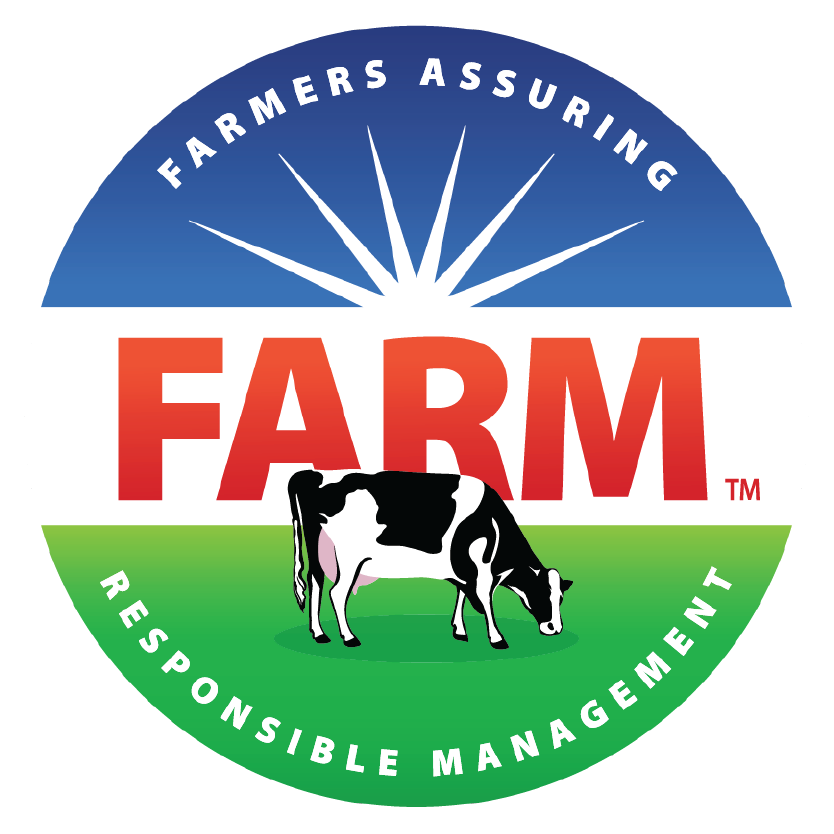Producing Renewable Energy: Solar
alternative practice names:
Solar Panels; Photovoltaics; Solar PV; Solar Thermal; Solar Hot Water; Agrivoltaics
Producing renewable energy from the sun has become increasingly popular on farms over the past decade as prices for the technology have declined. The two primary ways to harness renewable energy from the sun are using solar photovoltaic (PV) panels to generate electricity and using solar thermal panels to reduce water heating costs.
On dairy farms, installing solar PV panels to generate electricity is far more common than installing solar thermal panels because it is usually more cost-effective to reduce the farm’s water heating costs by using compressor heat recovery than using solar thermal panels.
Solar PV panels are either installed on the roofs of farm structures (e.g., a free-stall barn or milking parlor) or on the ground. Another increasingly popular type of solar PV project on dairy farms is agrivoltaics, where solar panels are raised up to accommodate dairy grazing below.
When used, in what regions in the U.S. is the practice found:
Northwest, West, Upper Midwest, Southwest, Northeast, Southeast
FARM SIZE
When used, typically found on farms of the following sizes:
All Sizes

Practice Benefits
Reduces operating costs: While the financial benefits of solar projects depend on factors like installation costs, the farm’s current electricity rates, and its ability to use tax credits and system depreciation, solar PV typically lowers electricity bills and offers a quick payback. Farms can also enter into a “power purchase agreement” where a third party owns and operates the solar system, allowing the farm to buy electricity at a fixed rate.
Fixed electricity rate: Solar projects provide a stable and predictable electricity cost for the life of the solar project (typically 20 to 30 years) because the electricity generated is not subject to electric utility rate increases.

Implementation Insights
Site-specific or Farm-specific requirements

Distance to the grid: Another key factor is the distance to the nearest electrical grid connection. Most farm solar projects are grid-tied, and a longer distance can raise costs. Off-grid systems avoid this but don't offer net metering, which allows farms to store excess energy from summer for use in winter. Battery storage can address this, but it adds significant cost.
Three-phase power: Most solar installations on farms require three-phase power, as three-phase systems can send more power back to the grid, reduce the risk of voltage rise by spreading the load across three cables, and deliver power more evenly across the structure. Smaller projects can sometimes work with single-phase power, but they lack the aforementioned advantages.
Required Capital Expenditures (CapEx)

Solar panels: Solar panels are the primary components of the system and are responsible for generating electricity.
Racking system: A racking system supports the solar panels, either for ground-mount or roof-mount installations.
Inverter: This converts the DC electricity generated by the panels into AC electricity.
Design and installation: Farms typically work with a solar project developer or solar engineering, procurement, and construction (EPC) company to design and build a solar project. Expenditures include labor, engineering, and technical services needed to set up the system, including ground preparation for ground-mounted systems or roof reinforcement for roof-mounted systems.
Interconnection: These expenses are related to connecting the system to the electric grid, which can increase if the site is far from the nearest grid connection.
Third-party review: Farms often rely on independent reviews from tax advisors or consultants to assess financial pro forma statements provided by solar vendors.
Required Operational Expenditures (OpEx)

Maintenance: Solar panels should ideally be cleaned periodically to maximize the amount of electricity generated, particularly if they are in a dusty area that doesn’t receive much rainfall. Ground-mount systems can require mowing if grass or other plants are blocking sunlight from reaching the solar panels. Most maintenance can be performed without skilled labor, but it is recommended to ask the installer of a solar project about operation and maintenance (O&M) costs; solar vendors often provide these services free of charge or have an O&M add-on package that include cleaning, monitoring, and inspection.
Inverters: These typically need to be replaced two to three times over the life of the project.
Implementation Considerations

System and vendor selection: Implementing a solar PV project on a dairy farm can be challenging due to various site-specific factors and the need to evaluate different vendors and solutions. Each farm’s unique energy needs, available space, and proximity to the electrical grid influence the project's feasibility. Working with experienced solar vendors and reviewing multiple proposals can help manage this complexity. Since solar policies vary by state, it is also important to consult local experts, such as university extension services or state agriculture departments, for valuable guidance. Leasing land for solar development requires additional consideration of contract terms and land use implications.
Site-related challenges: Unsuitable land or roof structures may prevent a project from moving forward or lead to costly repairs and modifications to accommodate the solar installation.
Permitting issues: Environmental permitting challenges or difficulties with interconnection to the electrical utility can arise. These may include lack of access to three-phase power, long distances between the installation site and grid access, or the utility's inability to approve additional solar projects at the farm’s substation.
Vendor and component issues: Selecting a disreputable or inexperienced solar vendor can lead to problems such as the use of low-quality components without warranties, difficulty contacting the vendor after installation, or inaccurate financial modeling for the project.
Financing and project economics: Before installation, the solar vendor typically provides a lifetime financial pro forma showing projected annual cash flow. It is important to carefully examine assumptions like loan rates, the expected annual increase in utility electricity costs, and tax credit treatment. Farms should consider consulting their tax accountant or a fiduciary experienced in solar project economics to review the financial pro forma, particularly to determine if the farm can benefit from the federal investment tax credit (ITC), renewable energy certificates (RECs), accelerated depreciation, and other state or local tax incentives.
Financial Considerations and Revenue Streams
TAX INCENTIVES AND DEPRECIATION
Virtually all solar projects take advantage of the federal investment tax credit (ITC), whether directly or indirectly. If the farm is profitable and pays taxes, there is an opportunity to take advantage of the federal solar ITC which currently allows businesses to claim 30% of their solar system cost as a tax credit. The 30% ITC will last until at least 2033, when it will drop to 26%. Tax credits are a one-for-one reduction in income tax and can be rolled over into future years if the farm can’t take advantage of them in the year of installation. Additionally, solar PV projects can be depreciated over a 5-year period (or less in some cases), which can help to improve project economics and lower the farm’s tax burden. If a farm cannot take advantage of tax credits or depreciation, they may be able to work with a solar project developer to reduce the project cost (where the developer or another entity monetizes the tax credit).
RENEWABLE ENERGY CERTIFICATES
Renewable energy projects typically generate renewable energy certificates (RECs). Solar project owners receive 1 REC for each megawatt-hour (1,000 kilowatt-hours) of electricity generated by the solar project. These RECs can then be sold to buyers who want to utilize them, typically for carbon offsets (see Offsets and RECs, EPA). There are many complexities surrounding RECs, and the value of RECs and ability to sell them varies from state to state. It is recommended to ask the solar vendor about how the project RECs can be monetized by the farm.
PROJECT FINANCING
Most farms opt to finance solar projects using a 15 to 25 year loan to reduce up-front costs. The loan term and interest rate have a dramatic impact on project economics, so it is important to seek out the best terms available. There are specialized loans available through state government, electric utility, or non-profit organizations that offer lower interest rates. Additionally, there are federal programs such as REAP that offer loan guarantees.
OTHER GRANTS AND INITIATIVES
Before purchasing and equipment for a solar project, it is critical to investigate grants and incentives available through local, state, and federal sources to ensure that the project remains eligible. It is common for grants and incentives to require that an application be submitted, reviewed, and/or approved before making equipment purchases. It is highly recommended to search the Database of State Incentives for Renewables & Efficiency® for grants and incentives specific to farm as a starting point.
CARBON CREDITS
This practice is commonly credited in carbon markets. The practice can generate inset credits.
Notes:
Opportunity may be limited if a utility company has already claimed the renewable energy credit.
This would be quantified and negotiated in each individual corporate program, including how long a producer could claim the benefit.
Generally, a producer would need to start using this practice to qualify.
These rules may also change by location subject to a state utility commission.
FINANCIAL RESOURCES, TOOLS, AND CASE STUDIES
Additional Resources
Article: A Brief Guide to On-Farm Solar (University of Maryland)
Article: Considerations for Leasing Land for Solar Development (University of Nebraska-Lincoln)
Article: Considerations when Leasing Agricultural Lands to Solar Developers (Cornell University)
Article: Farmer's Guide to Going Solar (U.S. Department of Energy)
Article: Solar Resources (Cornell University)
Website: AgriSolar Clearinghouse

Environmental Impacts
REDUCES FARM GREENHOUSE GAS FOOTPRINT
Solar panels generate electricity without emitting greenhouse gases (GHGs), displacing the need for fossil fuel-based electricity, which typically produces carbon dioxide and other GHGs. By integrating solar with energy storage or efficiency improvements, farms can further reduce emissions by stabilizing energy use and decreasing peak demand, which reduces the need for high-emission power sources during peak times.
REFerences

Alignment with FARM Program
FARM Environmental Stewardship (ES) V2-V3 Alignment
FARM ES enables users provide information about solar energy production and use, which is taken into account in the GHG intensity footprint.
Contents
We're always eager to update the website with the latest research, implementation insights, financial case studies, and emerging practices. Use the link above to share your insights.
We're always eager to update the website with the latest research, implementation insights, financial case studies, and emerging practices. Use the link above to share your insights.
Producing renewable energy from the sun has become increasingly popular on farms over the past decade as prices for the technology have declined. The two primary ways to harness renewable energy from the sun are using solar photovoltaic (PV) panels to generate electricity and using solar thermal panels to reduce water heating costs.
On dairy farms, installing solar PV panels to generate electricity is far more common than installing solar thermal panels because it is usually more cost-effective to reduce the farm’s water heating costs by using compressor heat recovery than using solar thermal panels.
Solar PV panels are either installed on the roofs of farm structures (e.g., a free-stall barn or milking parlor) or on the ground. Another increasingly popular type of solar PV project on dairy farms is agrivoltaics, where solar panels are raised up to accommodate dairy grazing below.
Practices and technologies
Producing Renewable Energy: Solar
alternative practice name:
Solar Panels; Photovoltaics; Solar PV; Solar Thermal; Solar Hot Water; Agrivoltaics
REGIONALITY
When used, in what regions in the U.S. is the practice found:
Northwest, West, Upper Midwest, Southwest, Northeast, Southeast
COMPARABLE FARM SIZE
When used, typically found on farms of the following sizes:
0 - 100 cows, 100 - 500 cows, 500 - 2500 cows, 2500 - 5000 cows, Over 5000 cows

Practice Benefits
Reduces operating costs: While the financial benefits of solar projects depend on factors like installation costs, the farm’s current electricity rates, and its ability to use tax credits and system depreciation, solar PV typically lowers electricity bills and offers a quick payback. Farms can also enter into a “power purchase agreement” where a third party owns and operates the solar system, allowing the farm to buy electricity at a fixed rate.
Fixed electricity rate: Solar projects provide a stable and predictable electricity cost for the life of the solar project (typically 20 to 30 years) because the electricity generated is not subject to electric utility rate increases.

Implementation Insights
Site-specific or Farm-specific requirements

Distance to the grid: Another key factor is the distance to the nearest electrical grid connection. Most farm solar projects are grid-tied, and a longer distance can raise costs. Off-grid systems avoid this but don't offer net metering, which allows farms to store excess energy from summer for use in winter. Battery storage can address this, but it adds significant cost.
Three-phase power: Most solar installations on farms require three-phase power, as three-phase systems can send more power back to the grid, reduce the risk of voltage rise by spreading the load across three cables, and deliver power more evenly across the structure. Smaller projects can sometimes work with single-phase power, but they lack the aforementioned advantages.
Required Capital Expenditures (CapEx)

Solar panels: Solar panels are the primary components of the system and are responsible for generating electricity.
Racking system: A racking system supports the solar panels, either for ground-mount or roof-mount installations.
Inverter: This converts the DC electricity generated by the panels into AC electricity.
Design and installation: Farms typically work with a solar project developer or solar engineering, procurement, and construction (EPC) company to design and build a solar project. Expenditures include labor, engineering, and technical services needed to set up the system, including ground preparation for ground-mounted systems or roof reinforcement for roof-mounted systems.
Interconnection: These expenses are related to connecting the system to the electric grid, which can increase if the site is far from the nearest grid connection.
Third-party review: Farms often rely on independent reviews from tax advisors or consultants to assess financial pro forma statements provided by solar vendors.
Required Operational Expenditures (OpEx)

Maintenance: Solar panels should ideally be cleaned periodically to maximize the amount of electricity generated, particularly if they are in a dusty area that doesn’t receive much rainfall. Ground-mount systems can require mowing if grass or other plants are blocking sunlight from reaching the solar panels. Most maintenance can be performed without skilled labor, but it is recommended to ask the installer of a solar project about operation and maintenance (O&M) costs; solar vendors often provide these services free of charge or have an O&M add-on package that include cleaning, monitoring, and inspection.
Inverters: These typically need to be replaced two to three times over the life of the project.
Implementation Considerations

System and vendor selection: Implementing a solar PV project on a dairy farm can be challenging due to various site-specific factors and the need to evaluate different vendors and solutions. Each farm’s unique energy needs, available space, and proximity to the electrical grid influence the project's feasibility. Working with experienced solar vendors and reviewing multiple proposals can help manage this complexity. Since solar policies vary by state, it is also important to consult local experts, such as university extension services or state agriculture departments, for valuable guidance. Leasing land for solar development requires additional consideration of contract terms and land use implications.
Site-related challenges: Unsuitable land or roof structures may prevent a project from moving forward or lead to costly repairs and modifications to accommodate the solar installation.
Permitting issues: Environmental permitting challenges or difficulties with interconnection to the electrical utility can arise. These may include lack of access to three-phase power, long distances between the installation site and grid access, or the utility's inability to approve additional solar projects at the farm’s substation.
Vendor and component issues: Selecting a disreputable or inexperienced solar vendor can lead to problems such as the use of low-quality components without warranties, difficulty contacting the vendor after installation, or inaccurate financial modeling for the project.
Financing and project economics: Before installation, the solar vendor typically provides a lifetime financial pro forma showing projected annual cash flow. It is important to carefully examine assumptions like loan rates, the expected annual increase in utility electricity costs, and tax credit treatment. Farms should consider consulting their tax accountant or a fiduciary experienced in solar project economics to review the financial pro forma, particularly to determine if the farm can benefit from the federal investment tax credit (ITC), renewable energy certificates (RECs), accelerated depreciation, and other state or local tax incentives.
Financial Considerations and Revenue Streams
TAX INCENTIVES AND DEPRECIATION
Virtually all solar projects take advantage of the federal investment tax credit (ITC), whether directly or indirectly. If the farm is profitable and pays taxes, there is an opportunity to take advantage of the federal solar ITC which currently allows businesses to claim 30% of their solar system cost as a tax credit. The 30% ITC will last until at least 2033, when it will drop to 26%. Tax credits are a one-for-one reduction in income tax and can be rolled over into future years if the farm can’t take advantage of them in the year of installation. Additionally, solar PV projects can be depreciated over a 5-year period (or less in some cases), which can help to improve project economics and lower the farm’s tax burden. If a farm cannot take advantage of tax credits or depreciation, they may be able to work with a solar project developer to reduce the project cost (where the developer or another entity monetizes the tax credit).
RENEWABLE ENERGY CERTIFICATES
Renewable energy projects typically generate renewable energy certificates (RECs). Solar project owners receive 1 REC for each megawatt-hour (1,000 kilowatt-hours) of electricity generated by the solar project. These RECs can then be sold to buyers who want to utilize them, typically for carbon offsets (see Offsets and RECs, EPA). There are many complexities surrounding RECs, and the value of RECs and ability to sell them varies from state to state. It is recommended to ask the solar vendor about how the project RECs can be monetized by the farm.
PROJECT FINANCING
Most farms opt to finance solar projects using a 15 to 25 year loan to reduce up-front costs. The loan term and interest rate have a dramatic impact on project economics, so it is important to seek out the best terms available. There are specialized loans available through state government, electric utility, or non-profit organizations that offer lower interest rates. Additionally, there are federal programs such as REAP that offer loan guarantees.
OTHER GRANTS AND INITIATIVES
Before purchasing and equipment for a solar project, it is critical to investigate grants and incentives available through local, state, and federal sources to ensure that the project remains eligible. It is common for grants and incentives to require that an application be submitted, reviewed, and/or approved before making equipment purchases. It is highly recommended to search the Database of State Incentives for Renewables & Efficiency® for grants and incentives specific to farm as a starting point.
CARBON CREDITS
This practice is commonly credited in carbon markets. The practice can generate inset credits.
Notes:
Opportunity may be limited if a utility company has already claimed the renewable energy credit.
This would be quantified and negotiated in each individual corporate program, including how long a producer could claim the benefit.
Generally, a producer would need to start using this practice to qualify.
These rules may also change by location subject to a state utility commission.
FINANCIAL RESOURCES, TOOLS, AND CASE STUDIES
Additional Resources
Article: A Brief Guide to On-Farm Solar (University of Maryland)
Article: Considerations for Leasing Land for Solar Development (University of Nebraska-Lincoln)
Article: Considerations when Leasing Agricultural Lands to Solar Developers (Cornell University)
Article: Farmer's Guide to Going Solar (U.S. Department of Energy)
Article: Solar Resources (Cornell University)
Website: AgriSolar Clearinghouse

Research
REFerences
REDUCES FARM GREENHOUSE GAS FOOTPRINT
Solar panels generate electricity without emitting greenhouse gases (GHGs), displacing the need for fossil fuel-based electricity, which typically produces carbon dioxide and other GHGs. By integrating solar with energy storage or efficiency improvements, farms can further reduce emissions by stabilizing energy use and decreasing peak demand, which reduces the need for high-emission power sources during peak times.

Alignment with FARM Program
FARM Environmental Stewardship (ES) V2-V3 Alignment
FARM ES enables users provide information about solar energy production and use, which is taken into account in the GHG intensity footprint.












